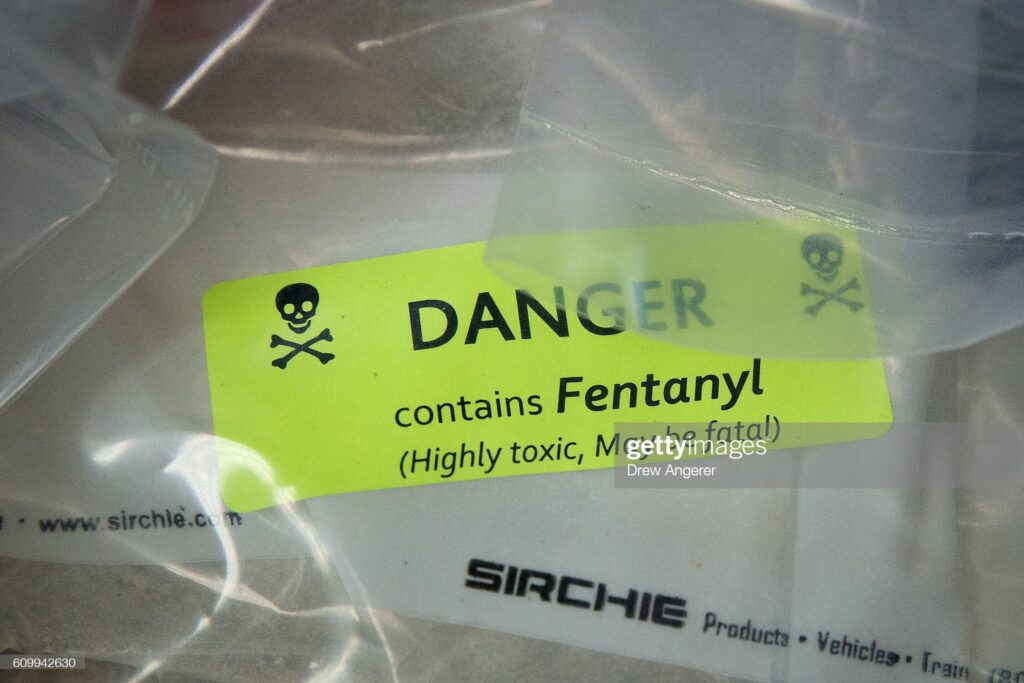April 2022 Drug Overdose Updates
Centers for Disease Control and Prevention
Fentanyl: one of the most deadly drugs- what you should know

Fentanyl is a synthetic opioid that is up to 50 times stronger than heroin and 100 times stronger than morphine. It is a major contributor to fatal and nonfatal overdoses in the U.S.1
There are two types of fentanyl: pharmaceutical fentanyl and illicitly manufactured fentanyl. Both are considered synthetic opioids. Pharmaceutical fentanyl is prescribed by doctors to treat severe pain, especially after surgery and for advanced-stage cancer.
However, most recent cases of fentanyl-related overdose are linked to illicitly manufactured fentanyl, which is distributed through illegal drug markets for its heroin-like effect. It is often added to other drugs because of its extreme potency, which makes drugs cheaper, more powerful, more addictive, and more dangerous.
Illicitly manufactured fentanyl
Illicitly manufactured fentanyl (IMF) is available on the drug market in different forms, including liquid and powder1.
Powdered fentanyl looks just like many other drugs. It is commonly mixed with drugs like heroin, cocaine, and methamphetamine and made into pills that are made to resemble other prescription opioids. Fentanyl-laced drugs are extremely dangerous, and many people may be unaware that their drugs are laced with fentanyl.
In its liquid form, IMF can be found in nasal sprays, eye drops, and dropped onto paper or small candies.
Fentanyl and other synthetic opioids are the most common drugs involved in overdose deaths.1 Even in small doses, it can be deadly. Over 150 people die every day from overdoses related to synthetic opioids like fentanyl.2
Drugs may contain deadly levels of fentanyl, and you wouldn’t be able to see it, taste it, or smell it. It is nearly impossible to tell if drugs have been laced with fentanyl unless you test your drugs with fentanyl test strips.
Test strips are inexpensive and typically give results within 5 minutes, which can be the difference between life or death. Even if the test is negative, take caution as test strips might not detect more potent fentanyl-like drugs, like carfentanil.3
Signs of overdose
Recognizing the signs of opioid overdose can save a life. Here are some things to look for:
- Small, constricted “pinpoint pupils”
- Falling asleep or losing consciousness
- Slow, weak, or no breathing
- Choking or gurgling sounds
- Limp body
- Cold and/or clammy skin
- Discolored skin (especially in lips and nails)
CDC’s Efforts to Prevent Overdoses
and Substance Use-Related Harms
2022-2024
Drug Overdoses: An Evolving Public Health Crisis
Drug overdoses have dramatically increased over the last two decades, with deaths increasing more than 500% between
1999 and 2020.1
• Overdoses are the leading cause of injury-related death in the United States with recent increases influenced by multiple factors including the COVID-19 pandemic.
• In 2020, nearly 92,000 people died from drug overdoses, a 30% increase from the approximately 71,000 overdose deaths in 2019.
• Among the 2020 overdose deaths, about 75% involved a prescription or illicit opioid, 62% a synthetic opioid other than methadone (e.g., illicitly manufactured fentanyl),
21% cocaine, and 26% a psychostimulant such as
methamphetamine.
• The rate of overdose deaths involving synthetic opioids other than methadone in 2020 was about 18 times the rate in 2013.
• For cocaine and psychostimulants, the 2020 rates were 4 and
6 times the 2013 rates, respectively.
• Deaths involving multiple drugs (i.e., polysubstance overdose deaths) are also increasing. In 2020, 79% of overdose deaths involving cocaine also involved an opioid and 62% of psychostimulant-involved overdose deaths also involved an opioid.
• Drug overdoses
impact families, communities, workplaces,
and the economy.
CDC’s Work is Guided by Six Principles and Five Strategic
Priorities to Address the Overdose Crisis
MISSION | Prevent Overdoses and Substance Use-Related Harms
GUIDING PRINCIPLES
Promote Health Equity Address Underlying Factors Partner Broadly
Take Evidence-Based Action
Advance Science
Drive Innovation
STRATEGIC PRIORITIES
Monitor, Analyze, and Communicate Trends
Build State, Tribal, Local, and Territorial Capacity
Support Providers, Health Systems, Payors,
and Employers Partner with Public Safety
and Community Organizations Raise
Public Awareness and Reduce Stigma
1 Wide-ranging
online data for epidemiologic research
(WONDER). Atlanta, GA: CDC, National Center for
Health Statistics; 2021. Available
at http://wonder.cdc.gov.
Promote Health Equity
All individuals have the right to be as healthy as possible. CDC is committed to ensuring everyone has an equitable opportunity to prevent overdose and substance use-related harms and remains dedicated to addressing and ending health disparities related to the overdose crisis. CDC also promotes actions to advance health equity to ensure all communities can fight the overdose crisis together.
Address Underlying Factors
Many factors contribute to harms associated with substance use while other factors can be protective. CDC is committed to identifying these factors to better design and focus interventions to address the overdose crisis, while attending to health disparities and inequities.
Partner Broadly
Addressing the overdose crisis requires partnering with multiple sectors and organizations within all of CDC’s strategic priorities. Partnerships provide opportunities to develop, coordinate, and implement targeted strategies to prevent harm. CDC is dedicated to broad and diverse partnerships as a foundation of preventing overdose and substance-use related harms.
Take Evidence-Based Action
To better address the overdose crisis, CDC promotes strategies that have been extensively
researched by scientists. Evidence-based action ensures the delivery (or implementation) of effective methods for preventing and reducing overdose and substance use-related harms that are translated and adapted for diverse audiences and settings.
Advance Science
Continuing to build the evidence-base for what works to prevent overdose and substance use- related harms is critical to ending the overdose crisis. By advancing science through supporting public health surveillance, identifying risk and protective factors, developing and evaluating prevention strategies, and ensuring effective communication strategies that are adapted for diverse audiences, CDC is committed to building the evidence-base for what works to end the overdose crisis.
Drive Innovation
The overdose
crisis will require new and innovative
ideas to prevent overdose
and substance use- related harms. CDC promotes the generation, implementation, evaluation, and widespread adoption of innovative ideas to
address the overdose crisis
in all areas of its work.
Monitor, Analyze, and Communicate Trends
Timely, high-quality data help public health officials and other decision-makers understand the extent of the problem, focus resources where they are needed most, particularly among populations disproportionately affected by overdose, and evaluate the success of overdose and substance use-related harm prevention efforts. Recognizing the importance of data, CDC is helping jurisdictions track overdose- related morbidity and mortality as well as use data to inform prevention activities.
Build State, Tribal, Local, and Territorial Capacity
States, tribes, local communities, and territories play an important role in preventing overdoses and substance use-related harms. They provide public health leadership; drive innovation; partner and collaborate; leverage surveillance to detect trends; and promote education, prevention (i.e., primary, secondary, and tertiary), and treatment. CDC works with jurisdictions to build their capacity in these and other areas to respond to the overdose crisis.
Support Providers, Health Systems, Payors, and Employers
Providers and health systems are crucial in promoting safer opioid prescribing and more effective and equitable pain management among adults and youth as well as providing evidence-based treatment for substance use disorders, particularly among disproportionately affected populations. In addition, health systems can implement quality improvement measures to track their efforts, integrate these
measures into their electronic health records, and support care coordination. Private and public insurers and pharmacy benefit managers can help address the overdose crisis by addressing gaps in coverage, removing barriers to treatment for substance use disorders and pain treatments, and conducting drug utilization reviews. Employers can play a critical role in preventing overdose by offering comprehensive benefits and supporting employees affected by substance use disorders.
Partner with Public Safety and Community Organizations
CDC continues to build multidisciplinary and diverse partnerships through public health and public safety collaborations at national, state, and local levels to strengthen efforts to reduce drug overdoses. These partnerships allow for effective and equitable implementation of programs and help advance promising strategies that address the overdose crisis, while helping to eliminate the longstanding impact of systemic inequities on overdose prevention. For example, public safety collaborations can reach individuals
during critical times such as involvement with the criminal justice system. In addition, partnerships with community organizations can link individuals to substance use disorder treatment or reduce substance use-related harms. These opportunities can bridge knowledge, data, and service gaps that impact the success of community-wide overdose prevention actions.
Raise Public Awareness and Reduce Stigma
CDC prioritizes raising awareness about all aspects of substance use including the risks of substance use and preventing associated harms among persons who use drugs, their families, and communities. In addition, CDC promotes evidence-based treatment for substance use disorders and advances understanding that addiction is a chronic disease. CDC also works to reduce stigma because stigma prevents people from seeking help for substance use disorders. CDC reduces stigma by addressing misinformation, endorsing non-stigmatizing language, and promoting awareness of stigma’s impact including among populations disproportionately affected by substance use and overdose.
